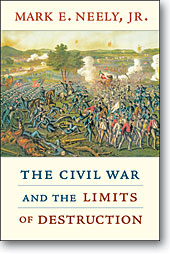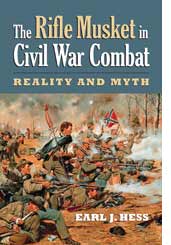I offer here two very different books on the Civil War, but both address what each author saw as “myths.” Mark E. Neely Jr. in his latest book The Civil War and the Limits of Destruction argues that the Civil War was really not that violent when compared to American warfare that took place versus the Mexicans and the Indians (race being the key issue). Earl J. Hess argues in The Rifle Musket in Civil War Combat: Reality and Myth, that the rifled musket really did not have the impact that historians have, for the most part, assumed.
 First off, I have a lot of respect for both historians and have read their previous work with delight. Mark E. Neely, Jr., is a Professor of the History of the Civil War Era at Pennsylvania State University, and is the author of a number of books, including his Pulitzer prize-winning “The Fate of Liberty: Abraham Lincoln and Civil Liberties.” Earl. J. Hess teaches history at Lincoln Memorial University and has published numerous books on the Civil War, including “The Union Soldier in Battle: Enduring the Ordeal of Combat”, and, most recently, “Trench Warfare under Grant and Lee: Field Fortifications in the Overland Campaign.”
First off, I have a lot of respect for both historians and have read their previous work with delight. Mark E. Neely, Jr., is a Professor of the History of the Civil War Era at Pennsylvania State University, and is the author of a number of books, including his Pulitzer prize-winning “The Fate of Liberty: Abraham Lincoln and Civil Liberties.” Earl. J. Hess teaches history at Lincoln Memorial University and has published numerous books on the Civil War, including “The Union Soldier in Battle: Enduring the Ordeal of Combat”, and, most recently, “Trench Warfare under Grant and Lee: Field Fortifications in the Overland Campaign.”
However, I left both books with perhaps more information, but nothing really new or exciting. Allow me to explain. Neely’s book continues on his theme that the Civil War was not a “total” war, but here he takes it to yet another and hopefully last step, that race played the critical role in the nature of combat. This, frankly, was a ho- hum and yawn argument for me as I was talking about this 2 years ago. I truly hope any Civil War historian worth anything knows that race has played an important role in American war ethos since the beginning. For example, if you have studied WW2 you know this. Also, his thesis has been argued before, and by others far more qualified than myself.
 Next up is Hess’ in-depth look at how historians have overrated the impact of the rifled musket on Civil War causalities. We’ve already known that the distance of engagement between the armed combatants of the war was really no different than that of other wars before or since. Also, the nature of the trajectory and the difficulty with aiming the rifle made accuracy problematic. Though I did learn a lot, the general thesis was another yawn as I had already been aware of it after reading Brent Nosworthy’s 2003 analysis The Bloody Crucible of Courage: Fighting Methods and Combat Experience of the Civil War, in which he (in not near as much depth) essentially covers the main points of Hess’ argument.
Next up is Hess’ in-depth look at how historians have overrated the impact of the rifled musket on Civil War causalities. We’ve already known that the distance of engagement between the armed combatants of the war was really no different than that of other wars before or since. Also, the nature of the trajectory and the difficulty with aiming the rifle made accuracy problematic. Though I did learn a lot, the general thesis was another yawn as I had already been aware of it after reading Brent Nosworthy’s 2003 analysis The Bloody Crucible of Courage: Fighting Methods and Combat Experience of the Civil War, in which he (in not near as much depth) essentially covers the main points of Hess’ argument.
These observations aside, both books add to the field and are good reads worth the money. If you’re a student or historian of the Civil War, both books are still must reads.
Greetings,
Thanks for your insight- I am regular on this site and enjoy keeping myself up-to-date on matters of the past. Now that’s an oxymoron! (I apologize for the bad humor. It’s been a long day.) That said, I thought I’d bring a little history of my own for you to check out. I came across an article this morning on this website: http://www.petermanseye.com/anthologies/what-was-learned/334-the-16th-amendment
It’s a blog regarding the history of US taxes. With everything government-related going on lately, I found this very enjoyable to read. Check it out, and enjoy. Thanks again.
Cheers.
Thanks very much, this will help me with my history test…